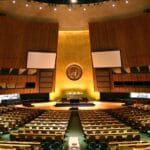The case for the CTBT: Stronger than ever
By Kingston Reif | April 9, 2012
In his April 2009 speech in Prague, President Barack Obama outlined a vision of a world free of nuclear weapons and pledged to “immediately and aggressively” pursue approval of the Comprehensive Nuclear Test Ban Treaty (CTBT), which prohibits any nuclear test explosions that produce a self-sustaining, supercritical chain reaction and creates a robust international verification regime. Now, within days of the second Obama-initiated global Nuclear Security Summit, the National Research Council of the National Academy of Sciences (NAS) has released its much-anticipated report on the technical and security issues related to the CTBT. It provides ample evidence that the case for the test ban has never been better.
In 1996, the United States was the first country to sign the CTBT, but in 1999, the US Senate rejected the treaty. That year, Republicans who opposed the test ban did so largely on the grounds that the US nuclear deterrent cannot be maintained without testing and that the treaty is unverifiable. While the NAS report does not take a position on whether the United States should ratify the CTBT, it does conclude that the “United States is now better able to maintain a safe and effective nuclear stockpile and to monitor clandestine nuclear-explosion testing than at any time in the past.” In other words, in this day and age, concerns about the maintenance of the stockpile and verification of the treaty are no longer compelling arguments. In short, the United States should ratify the CTBT as soon as possible: It has nothing to lose and everything to gain.
Authored by an independent panel of nine eminent technical and security experts, the NAS report provides a review and assessment of the changes that have occurred in the decade since the NAS last examined these issues in 2002. In particular, the report evaluates the US ability to maintain a safe and reliable nuclear weapons stockpile without nuclear testing, the status of nuclear-explosion detection, and whether new technical advances would threaten or ensure US security under the treaty.
Nuclear weapons without nuclear testing. “Provided that sufficient resources and a national commitment to stockpile stewardship are in place,” the report states, “the committee judges that the United States has the technical capabilities to maintain a safe, secure, and reliable stockpile of nuclear weapons into the foreseeable future without nuclear-explosion testing.” In fact, the authors go on to say that “[t]he technical capabilities for maintaining the U.S. stockpile absent nuclear-explosion testing are better now than anticipated by the 2002 Report.” The United States knows more about maintaining its nuclear weapons today than ever before.
In addition to a stronger grasp of the technology, the National Nuclear Security Administration has received enormous funding increases in recent years specifically to ensure the long-term health of the stockpile in the absence of testing. For example, the fiscal year 2013 request of $7.6 billion for the security administration’s weapons activities account is an increase of $1.2 billion over the fiscal 2010 level. As Senator Dianne Feinstein noted at an appropriations committee hearing last month, “I believe the fiscal year 2013 budget request provides more than sufficient funding to modernize the nuclear weapons stockpile.” Between America’s advanced understanding of technical measures and sufficient money to maintain those measures, testing nuclear weapons is plainly no longer necessary to ensure US security.
Detection. The United States has gained a more sophisticated understanding of monitoring capabilities in the last 10 years: “The status of U.S. national monitoring and the International Monitoring System (IMS) has improved to levels better than predicted in 1999.” Any state that might consider cheating on the treaty by testing a nuclear weapon would run a very high risk of detection. Approximately 80 percent of the stations planned as part of the International Monitoring System — a global network of detection systems and technologies — are already in place. Though less robust at the time, this same monitoring system detected the North Korean nuclear test explosions in 2006 and 2009.
The CTBT also provides for short-notice, on-site inspections that can be used to confirm violations detected by the verification system. According to the report, “Constraints placed on nuclear-explosion testing by the monitoring capabilities of the IMS and U.S. [National Technical Means] will reduce the likelihood of successful clandestine nuclear-explosion testing.” And, perhaps more significant, the treaty’s prohibition on testing buttressed by the threat of detection will “inhibit the development of new types of strategic nuclear weapons.”
Security. The NAS report greatly reinforces the national security case for the treaty. The report states that, while the United States must maintain the technical “capabilities needed to sustain US national security into the future, the results of this committee’s deliberations have shown that these concerns are not the result of intrinsic technical limitations and are not limited by a possible future under the CTBT.” In other words, US adherence to the CTBT would not prevent the United States from maintaining its nuclear warheads without testing — just as the United States has been doing for the last 20 years. But it would make it harder for other states to conduct nuclear tests — and thereby improve their nuclear arsenals. It would also be far more difficult for countries to pursue new nuclear advances through evasive testing with the CTBT in force than it would be with unconstrained testing in the absence of the treaty. To be sure, states could produce simpler, “gun-type” nuclear weapons without testing as the United States did with the weapons it dropped on Hiroshima, but states can do that now. And the United States, as the NAS report notes, “could respond equally well whether or not the CTBT were in force.”
Treaty opponents have long argued that the test ban does not adequately define a “nuclear test.” While the United States holds a “zero-yield” interpretation of the treaty, critics maintain that Russia and China have a different interpretation, one that would allow them to improve their arsenals by conducting very low-yield nuclear tests that could not be detected. The dubiousness of this claim about the disputed scope of the treaty notwithstanding, the NAS report notes, “Because such tests may be undetectable, these advances could be made whether or not the CTBT were in force.” And “the United States would be able to respond to them as effectively under the CTBT as it could without the CTBT.”
And even then there’s a fail-safe. If an adversary’s illicit nuclear activities required the United States to develop a new kind of nuclear weapon that could not be certified without testing, American leaders could invoke the treaty’s “supreme national interest clause” and simply withdraw from the agreement.
What’s more, the United States has not conducted a nuclear test since September 1992 and has no plans to resume explosive testing. As Lt. Gen. Frank Klotz, former commander of Air Force Global Strike Command, recently put it, “Absent a radical change in the international environment, the political barriers to a resumption of testing would be practically insurmountable.” Given that testing is not on the political agenda and isn’t necessary to the maintenance of the arsenal, that detection capabilities are at an all-time high, and that national security would be improved under the treaty, it’s difficult to understand why the United States would not take advantage of the CTBT. After all, the United States has conducted 1,030 nuclear tests — more than all other nations combined. The body of knowledge the United States has gleaned from this matchless testing history means that a permanent test ban would provide the nation with an enormous security advantage relative to other nuclear-armed states.
As of March 2012, 157 countries have ratified the CTBT. However, the treaty will not enter into force until 44 states that have been deemed “nuclear capable” have also ratified it — including China, Egypt, India, Iran, Israel, North Korea, Pakistan, and the United States. But a move forward by the United States would establish the leadership needed to bring other countries along. If nothing else, China has indicated that it will ratify if the United States does. This would further strengthen the global norm against nuclear testing and encourage other holdouts, such as India and Pakistan, to ratify, reducing the possibility of a dangerous arms race in South Asia.
After the longer-than-anticipated effort to win Senate approval of New START, the administration postponed plans to seek a vote on the CTBT in its first term. Instead, the White House has begun a cautious campaign to engage with the Senate on the treaty in preparation for a possible Senate vote in Obama’s second term (should he win reelection). A critical piece of this outreach has been to encourage senators to carefully examine the remarkable improvements in America’s ability to maintain the arsenal (via the stockpile-stewardship program) and to detect nuclear testing. In order to assist senators, the administration commissioned both the NAS report and a classified National Intelligence Estimate on the US ability to verify compliance with the treaty.
For ratification to proceed, Republican senators will have to resist undoubtedly strong political pressure to rush to judgment and instead closely examine the technical advances that have been made over the past decade. In the words of George Shultz, former secretary of state under Ronald Reagan, “[Republicans] might have been right voting against [the CTBT] some years ago, but they would be right voting for it now, based on these new facts.”
Together, we make the world safer.
The Bulletin elevates expert voices above the noise. But as an independent nonprofit organization, our operations depend on the support of readers like you. Help us continue to deliver quality journalism that holds leaders accountable. Your support of our work at any level is important. In return, we promise our coverage will be understandable, influential, vigilant, solution-oriented, and fair-minded. Together we can make a difference.
Topics: Columnists, Nuclear Weapons















